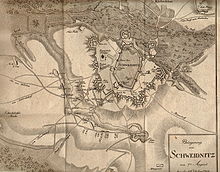Siege_of_Schweidnitz_(1762)
Siege of Schweidnitz (1762)
1762 siege
The siege of Schweidnitz took place between August and October 1762 during the Third Silesian War, part of the wider Seven Years' War. Prussian forces under the overall command of Frederick II laid siege to the city of Schweidnitz, in an attempt to retake it from an Austrian garrison.


